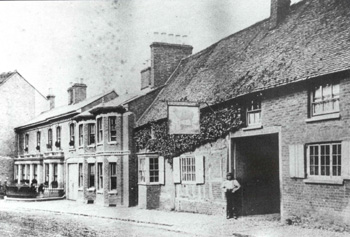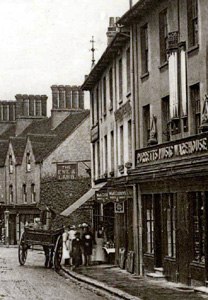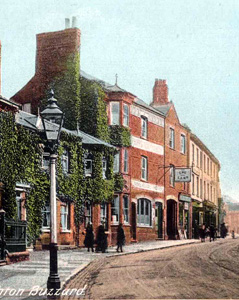The Ewe and Lamb Public House Leighton Buzzard
The Ewe and Lamb Public House: 17 Bridge Street, Leighton Buzzard [also the Old Ewe and Lamb and the Ewe Lamb & Shepherd]

The Ewe and Lamb about 1855
The Old Ewe and Lamb
The Manor of Leighton Buzzard alias Grovebury was the principal landowner in the town before the 19th century. Bedfordshire & Luton Archives & Records Service has a full run of court rolls from 1393 to 1727 [KK619-715] and another full run from 1704 to 1867 [X288/1-23]. The service also has court rolls for other manor to own land in the town, the Prebendal Manor, from 1448 to 1459, 1588 to 1591, 1611 to 1622, 1627 and 1631 [KK792-1798]. Detailed study of these would be bound to produce quite full histories for most licensed premises in the town. Unfortunately such study would take a very long time. Thus the histories of licensed premises in these web pages are quite summary and not necessarily the full story.
The countywide register of alehouse licences of 1876 states that the Ewe and Lamb was first licensed in 1647. It has been proved that the register is not always accurate on dates of first licensing and this date may have been taken from the evidence of a piece of wood mentioned in an account or a pub crawl written in the 1950s [see below]. The first mention of the Ewe and Lamb so far traced is in 1731 when Elizabeth Blackhead, sister and heir of Thomas Blackhead was admitted to the copyhold Ewe and Lamb in Lovell End, as Bridge Street was then called [X288/5]. Elizabeth Blackhead was originally a Seabrooke who had married Charles Blackhead of Wing in 1712
Elizabeth Blackhead died in 1746 and her son Thomas was then admitted to the public house [X288/5]. Thomas died five years later and his sister, Mary Rickard, was duly admitted to the property [X288/5]. Mary died in 1762 and her brother William was then admitted [X288/7]. In the Northampton Mercury of 19th January 1793 licensees of Leighton Buzzard subscribed to a resolution banning "seditious and disaffected persons" from their houses. This presumably was in reaction to the events across the Channel in France (four days previously King Louis XVI had been sentenced to death and two days later he went to the guillotine). Interestingly the list of licensees also includes a John Rolfe at the Old Ewe and Lamb and a John Norman at the Ewe and Lamb. This clearly suggests that Rolfe inhabited the long established house whereas Norman occupied a newer rival. Rolfe was admitted as tenant to the copyhold Old Ewe and Lamb in May 1793, on the surrender of John Edge [RY1196]. It was then described as a cottage in Lovell End fronting south onto the street. Rolfe sold the establishment to Aylesbury [Buckinghamshire] brewer Charles Lucas in 1795 and John Norman purchased it from him two years later [RY1196]. This united the Old Ewe and Lamb with its newer rival in one ownership. In 1855 the Ewe and Lamb was owned by William Loke who also owned a cottage described as a cottage divided into two tenements in Lovell End facing south onto the street lately erected on the site where a cottage in two tenements stood and known as the Ewe and Lamb, formerly occupied by John Rolfe [RY1229]. It is not explicitly stated but the inference is that this cottage stood next door, or at least very, near to the then Ewe and Lamb, which would probably put it on the site of today's 15 or 19 Bridge Street

The Ewe and Lamb about 1900 [Z1306-72]
The later Ewe and Lamb, also the Ewe, Lamb and Shepherd
It is not known when the newer Ewe and Lamb, on the site of today's 17 and 17a Bridge Street, first opened its doors but it was clearly owned by John Norman in 1793. John Norman also owned an inn about which little is known, the Maidenhead, also in Lovell End. It seems likely that the Maidenhead was either on the site of today's 15 Bridge Street or today's 19 or 21, meaning that for a while three public houses may have formed a row (as the Curriers Arms, Boot and Cross Keys later did in Middle Row). Benjamin Bevan's map of Leighton Buzzard of 1819 and the accompanying reference book of 1821 denote the Ewe and Lamb as number 27 (no Old Ewe and Lamb is mentioned) on the map. Norman was dead by then but the Ewe and Lamb was owned by his executors who also owned the rest of the block from 15 to 21 Bridge Street. Norman was, in fact, dead by 1820 as in that year Benjamin Hopkins and Jeremy Willis were admitted to the Ewe and Lamb as his executors in trust to pay annuities to Norman's sisters Mary Aires or Aris or Arist and Elizabeth watts and his sister-in-law Mary Heathcote. When his grandson William became 21 the Norman's properties were to go to him [RY1196]. By the time of the first surviving countywide register of alehouse licences of 1822 the Ewe and Lamb had been renamed the Ewe, Lamb and Shepherd [CLP13]. William Norman mortgaged the Ewe and Lamb to George Garrett in 1834, with a further advance in 1836 [RY1196].
In 1839 Norman sold the Ewe, Lamb and Shepherd to William Loke, a baker, and in 1855 William's son John was admitted to the property on his father's surrender, together with a cottage which had been the Old Ewe and Lamb [RY1229]. John Loke enfranchised the Ewe, Lamb and Shepherd in 1875 [RY1273] - this means that he paid the Lord of the Manor in order to convert the premises from copyhold to freehold. The countywide Return of Licensed Premises of 1876 notes that the occupier of the ewe and Lamb was John Loke and the owner John Loke senior. By 1891 the owner was Phipps & Company of Northampton and records relating to the public house may be held at Northamptonshire Record Office.
At the transfer of tenancy from Millward to Fish in 1912 the premises was valued and an inventory of the contents taken [BML10/42/375]. The layout of the building seems to have been as follows:
- Second floor: right front bedroom; middle front room; top landing; small room;
- First floor: right front bedroom; middle front bedroom; back bedroom; landing and stairs; bathroom; drawing room; lavatory;
- Ground floor: back sitting room; bottom passage; market room; tap room; bar; private bar; kitchen; gas lobby;
- Basement: cellar;
- Outside: malting with a loft over; stable; garden
The contents of the Market Room were as follows: five 4 foot mahogany tables; thirty four Windsor chairs; two elbow chairs; three extra elbow chairs; twelve bentwood chairs; three extra bentwood chairs; two looking glasses in a mahogany frames; an iron and steel fender and set of fire irons; two brass spittoons; a clock in a marbled case; a four light bronzed gas pendant and two burners; a two light bronzed gas pendant with two indandescent burners; two bell shaped globes; five rolling sun blinds and fittings; a curtain rod; five opaque glass blinds in mahogany frames; linoleum "as laid to front part"; two hearth rugs; an oak hat and umbrella stand; an iron curb fender; a set of fire irons; a Japanned coal hod and shovel; linoleum "as laid to the back portion"; two rolling blinds and fittings and a brass curtain rod with rings, ends and brackets. The tap room contained: a gas bracket; a rolling blind and fittings; two oak tables; a stool; an iron return fender and fire irons and a coal scuttle.
The bar contained: Stockers Patent five pull beer engine; six white metal taps with pipes and unions forming spirit fountains; six earthenware spirit jars with taps, five holding twelve gallons and one ten gallons; one high pressure water pipe from the cistern; foru1 gallon crimson and gold spirit jars with plated taps and lettered; two 2 light gas pendants and two incandescent burners; a large rolling sun blind and fittings; three small rolling sun blinds and fittings; a Mahogany cigar cupboard with a pair of glazed doors and a glass centre panel; cocoa matting and linoleum; two brass rails and brackets; six spouted pewter pints; seven plain pewter pints; a quart pewter beer measure; five spirit measures; two earthen spouted quarts; two earthen spouted pints; six blue pint mugs; a water can; a stool; twenty three ale glasses; ten half pint tumblers; fourteen wine glasses; twenty spirit tumblers; twent four stamped pint ale glasses; ten grog glasses; six soda glasses; seven decanters; two water jugs; two funnels; three waiters; two cork screws; a biscuit barrel; nine sherry glasses; eight port glasses; thirteen liqueur glasses; fifteen odd sherry glasses; two fly bottles; three tall ale glasses; one tumbler; two tinted tumblers and four Japanned jugs. The private bar contained three bentwood chairs and linoleum.
The garden contained a fowl house with seventeen inhabitants, garden tools, "crops in the garden" and a gas regulator. Stock in trade comprised: "Wines, Spirits, Cordials, Beer, Minerals, Tobacco and Cigars". the entire contents were valued at £164/13/11.
Under the terms of the Rating and Valuation Act 1925 every piece of land and building in the country was assessed to determine the rates to be paid on them. Leighton Buzzard was assessed in 1925, unfortunately the volume listing public houses was never deposited with Bedfordshire & Luton Archives & Records Service but 17a Bridge Street was by then a private house and the valuer described it [DV1/R56/40] as owned Phipps & Company Limited and occupied by Mrs. Rebecca Hines at a rent of 3/5 per week. The ground floor contained just a washhouse and the first floor two bedrooms measuring 10 feet by 12 feet and 8 feet by 13½ feet as well as a kitchen measuring 9 feet by 10 feet and a "sink place". The second floor comprised bedrooms measuring 10 feet by 15 feet and 10½ feet by 9 feet. Outside stood a W.C.
Article in Volume III of Bedfordshire Magazine by Page Woodcock, 1952, page 193: "Like some other houses in Leighton, the Ewe and Lamb in High Street [sic] still retains its market room, a relic of the days when folk sat at the common dining table. Whilst draymen delivered the week's supply, the Ewe and Lamb's landlord busied himself with cellar-flaps, we gazed around the now dispirited room with its empty tables. Glassy-eyed pike and perch stared from showcases; sporting prints and Victorian artists' conceptions of the classics hung on the walls, with a fox's and two antlered stags' heads above. Mr. Simms, the landlord, returned to talk of more convivial days. In his twenty-two years tenancy (And I'm still a furriner") there has been much change. Ewe and Lamb's stable yard now caters for only two of the old-stagers who remain faithful to the pony and trap. Once it was thronged with horse traffic. The livery stables and the old malting now have other uses. A glass-fronted polyphone stood in the bar, a kind of early juke-box which, on the insertion of a penny would produce a tink-tanketting hullabaloo by means of large revolving metal discs…It is an old house, rebuilt and altered over the years. Mr. Simms showed us a triangular chunk of oak inscribed '1647'. "Each landlord has taken it over for donkey's years" he said. Was it from a rebuilding after the bad years of '45 and '46? Outside in the yard we saw relics of reconstruction. Above the disused stables the inscription 'JL. SL. JL. GL. 1855' denotes that the Lakes (of Lake Street) rebuilt it in that year". The 1647 date seems to be the source for the statement in the 1876 licensing register that the ewe and Lamb was first licensed in that year - this, of course, would be the Old Ewe and Lamb, probably on an adjoining site as discussed above.
The reference to rebuilding in 1855 is interesting. The photograph at the head of this page shows the Ewe and Lamb around the middle of the 19th century (to judge by the dress of the man, probably John Loke, standing by the entrance to the courtyard) and clearly shows different premises to the three storey structure of today.
The Ewe and Lamb finally closed its doors in 1972. It is now [2008] the headquarters of the Leighton Buzzard Observer.

The Ewe and Lamb about 1910 [Z1306-72]
References:
- X288/5: admission: 1731;
- X288/5: admission: 1746;
- X288/5: admission: 1751;
- X288/7: admission: 1762;
- Northampton Mercury: resolution of Leighton Buzzard publicans banning "seditious and disaffected persons" from their houses: 19 Jan 1793;
- RY1196: admission: 1793;
- RY1196: admission: 1795;
- RY1196: admission: 1797;
- RY1196: admission: 1820;
- CLP13: Register of alehouse licences [Ewe, Lamb & Shepherd]: 1822-1828;
- RY1196: mortgage: 1834;
- RY1196: mortgage: 1836;
- RY1229: admission: 1855;
- PSLB4/1: Register of Alehouse Licences - Leighton Buzzard Petty Sessional Division: c.1860s-1949;
- PSLB4/3: Register of Alehouse Licences - Leighton Buzzard Petty Sessional Division: c.1860s-1956;
- BML10/42/18: auction sale held at public house: 1866;
- RY1273: enfranchisement: 1875;
- HN1/20-1-3: position shown on annotated Ordnance Survey maps compiled for licensing purposes: early 20th century;
- BML10/42/375 and BML10/44/100: inventory and valuation: 1900;
- BML10/42/375: inventory and valuation: 1912;
- PSLB4/2: Register of Alehouse Licences - Leighton Buzzard Petty Sessional Division: 1922-1948;
- Z1105/1: Liquor Licence Traders Survey Form: 1955

17 and 17a Bridge Street June 2008
List of Licensees: note that this is not a complete list; entries in italics refer to licensees where either beginning or end, or both, dates are not known:
1793: John Norman;
1822: Richard White;
1828: Edward Loke;
1847: John Loke;
1850: William Loke;
1853: John Loke;
1888: Sarah Ann Dowson [convicted 24 Jan 1893 of permitting drunkenness on licensed premises; fined £1 with 11/6 costs];
1893: Alfred Ryder;
1900: William David Millward;
1912: Henry James Fish;
1917: Henry Bunn Scrivener;
1926: Harold Emmerton Cowley;
1929: Job Franklin;
1930: Arthur Ernest Simms;
1953: Walter Leonard Wilkinson;
1971: Eric Raymond Essam.
Public house closed 1972